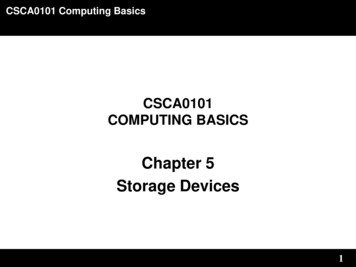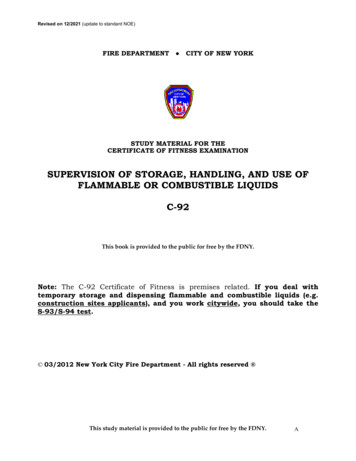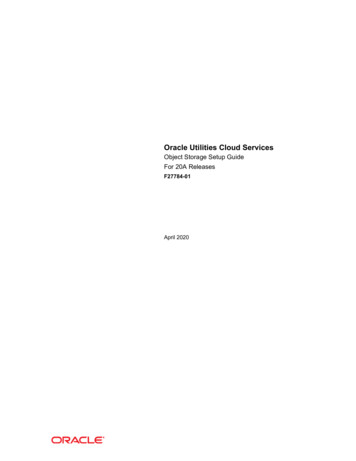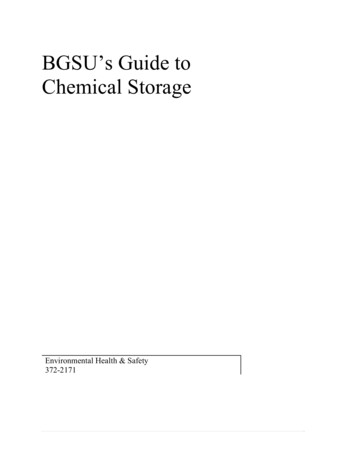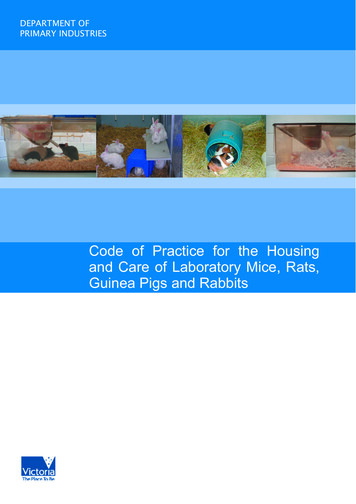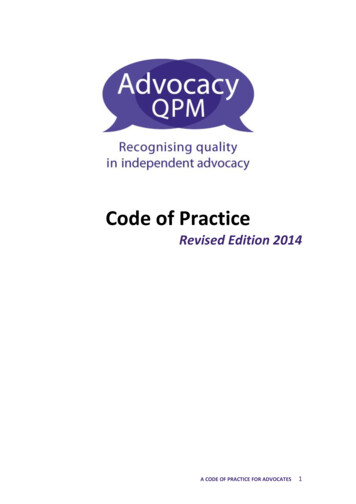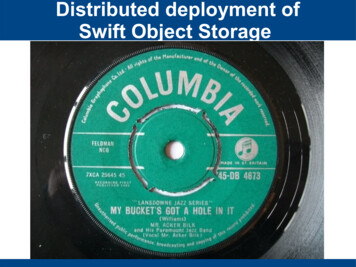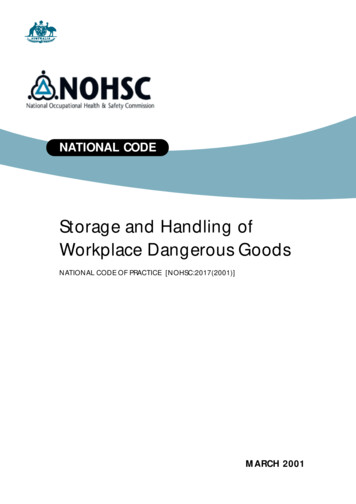
Transcription
NATIONAL CODEStorage and Handling ofWorkplace Dangerous GoodsNATIONAL CODE OF PRACTICE [NOHSC:2017(2001)]MARCH 2001
Storage and Handling ofWorkplace Dangerous GoodsNATIONAL CODE OF PRACTICE [NOHSC:2017(2001)]March 2001National Occupational Health and Safety CommissionSydney
Commonwealth of Australia 2001ISBN 0-642-43303-8This work is copyright. Apart from any use as permitted under the Copyright Act 1968, nopart may be reproduced by any process without prior written permission from theCommonwealth available from Info Products. Requests and inquiries concerning reproductionand rights should be addressed to the Manager, Legislative Services, Info Products,Department of Finance and Administration, GPO Box 1920, Canberra, ACT 2601.ii
FOREWORDIn seeking to achieve Australian workplaces free from injury and disease, NOHSC works to leadand coordinate national efforts to prevent workplace death, injury and disease. We seek toachieve our mission through the quality and relevance of information we provide and toinfluence the activities of all parties with roles in improving Australia’s OHS performance.NOHSC has five strategic objectives: Improving national data systems and analysis, Improving national access to OHS information, Improving national components of the OHS and related regulatory framework, Facilitating and coordinating national OHS research efforts, and Monitoring progress against the National OHS Improvement /framework.This publication is a contribution to achieving those objectives.
CONTENTSFOREWORD. iiiPART A — PRELIMINARY . 11.TITLE . 12.DECLARATION . 13.PURPOSE . 14.SCOPE AND APPLICATION . 15.INTERPRETATION . 46.INCORPORATION OF REFERENCES . 47.OBLIGATIONS ON MORE THAN ONE PERSON . 5PART B — DUTIES . 68.GENERAL DUTY OF CARE . 69.DANGEROUS GOODS . 610.PROVISION OF MATERIAL SAFETY DATA SHEETS . 911.PROVISION OF OTHER INFORMATION . 1012.PLANT AND STRUCTURES USED FOR STORAGE AND HANDLING . 1013.HAZARD IDENTIFICATION . 1314.RISK ASSESSMENT . 1615.CONTROL OF RISK . 1816.SEPARATION BY PHYSICAL MEANS . 2717.SEGREGATION OF DANGEROUS GOODS . 2818.STABILITY OF DANGEROUS GOODS . 2919.CONTAINERS FOR BULK DANGEROUS GOODS . 2920.SPILLS AND CONTAINMENT . 3121.IMPACT PROTECTION . 3222.TRANSFER OF DANGEROUS GOODS . 3323.FIRE PROTECTION . 3424.EMERGENCY PREPAREDNESS . 3925.IGNITION SOURCES IN HAZARDOUS AREAS . 4326.SAFETY EQUIPMENT . 4527.CONTROL OF HAZARDOUS ATMOSPHERE . 4528.LIGHTING . 4629.ACCESS . 4730.SECURITY . 47
31.DECOMMISSIONING/ABANDONING/DISPOSAL . 4832.DANGEROUS GOODS INFORMATION . 4833.PLANT AND STRUCTURES USED FOR STORAGE AND HANDLING . 4934.IDENTIFICATION . 5235.IMMEDIATE USE CONTAINERS . 5336.PLACARDS . 5337.OUTER WARNING PLACARDS . 5438.PLACARDS FOR BULK . 5439.PLACARDS FOR PACKAGED DANGEROUS GOODS . 5540.MANIFEST AND SITE PLAN OF THE PREMISES . 5541.DANGEROUS OCCURRENCES . 5742.REORTING DANGEROUS OCCURRENCE OR NEAR MISSES 42 – 44. . 5845.NOTIFICATION CLAUSE . 5847.CONSULTATION . 5948.INDUCTION, INFORMATION, TRAINING AND SUPERVISION . 6049.AVAILABILITY OF RISK ASSESSMENT RECORD . 6250.VISITORS . 6351.MATERIAL SAFETY DATA SHEETS . 6352.REGISTER FOR DANGEROUS GOODS . 6553.DUTIES OF EMPLOYEES. . 6554.DUTIES OF ALL PERSONS . 6555.PIPELINES - GENERAL . 6656.NOTIFICATION REQUIREMENTS FOR THE OWNER OF A PIPELINE. . 6657.ACKNOWLEDGEMENT OF NOTIFICATION BY THE AUTHORITY . 66APPENDIX 1 - MINOR QUANTITIES . 67APPENDIX 2 - RETAIL PREMISES . 73APPENDIX 3 - PUBLICATIONS INCORPORATED IN THIS CODE . 78APPENDIX 4 - A SYSTEM FOR RANKING RISKS . 82APPENDIX 5 – CHECKLIST FOR IDENTIFYING HAZARDS LIQUIDS. . 85APPENDIX 6 – GUIDELINES FOR IDENTIFYING HAZARDS ASSOCIATEDWITH PLANT AND EQUIPMENT USED IN THE STORAGE AND HANDLINGOF DANGEROUS GOODS . 90APPENDIX 7 - CONTROL OF PARTICULAR RISKS . 93APPENDIX 8 – ENGINEERING CONTROLS WORKSHEET FOR STORAGEAND HANDLING INSTALLATIONS . 96
APPENDIX 9 – GUIDANCE FOR INDUSTRIAL TRUCKS USED INHAZARDOUS AREAS . 105APPENDIX 10 - EXEMPTION QUANTITIES FOR PACKAGE LABELLING . 107APPENDIX 11 - FLOW DIAGRAMS FOR PLACARDING PREMISESAND WORK AREAS . 108APPENDIX 12 - SAMPLE MANIFEST FORM . 110APPENDIX 13 - SAMPLE PLAN OF PREMISES . 112APPENDIX 14 - SAMPLE EMERGENCY PROCEDURES POCKET CARD . 113APPENDIX 15 - DANGEROUS GOODS COMPATIBLITY CHART – Under construction. 115vi
INTRODUCTIONThe National Code of Practice for the Storage and Handling of Workplace Dangerous Goodsprovides guidance on how to comply with the requirements set out in the National Standard forthe Storage and Handling of Workplace Dangerous Goods (referred to in this document as thenational standard). This national code of practice should therefore be read in conjunction withthe national standard.Dangerous goods are widely used throughout the community under a variety of conditions, byindustry, commerce and institutions, and in domestic residential situations. The methods forcomplying with the national standard may vary widely, depending on the nature and scope ofthe operations, the extent of involvement with dangerous goods, and whether or not there iscontact with the general public.In line with recent developments in occupational health and safety legislation, the nationalstandard establishes performance objectives and allows industry the maximum practicableflexibility in achieving those objectives. Consistent with that approach, this national code ofpractice wherever possible allows for alternative approaches to achieving compliance with thenational standard depending on the needs of the facility.Where more detail is required than is provided in this code of practice, users are guided in thedirection of documents, including Australian Standards, that identify particular technicalspecifications for the safe storage and handling of certain types of dangerous goods underspecific conditions. Australian Standards, industry and other codes of practice may assist inmany situations, but detailed compliance with these is not mandatory, provided it can bedemonstrated that the requirements of the national standard can be met.To this end a more extensive list of related standards and codes of practice is provided atAppendix 3. These standards and codes are incorporated in this national code and whereappropriate may be relevant to complying with the national standard. .Other references that may also be useful, include overseas standards and industry codes ofpractice. For instance, the Australian Gas Association industry codes of practice which providedetailed requirements applicable to some circumstances where Class 2.1 dangerous goods arestored and handled.A number of aids, such as checklists, flowcharts and sample forms have been included to assistindustry to comply.The national code provides information and guidance for the storage and handling ofdangerous goods in minor quantities and in consumer packages supplied by retailers. However the occupier, of premises where minor quantities of dangerous goods are storedand handled, can elect to control those goods using Appendix 1 or apply the riskmanagement provisions of the national standard in conjunction with the requirements ofthe relevant Australian Standard for the dangerous goods on the premises. Provisions for the control of dangerous goods stored and handled on a retailer’s premises isincluded in Appendix 2 – Retail Premises.vii
In the decimal numbering system used in this national code of practice, paragraph numberscommence with the number of the corresponding clause in the national standard to which theyrefer. Where a specific clause in the national standard is referenced in this code of practice,the letters “NS” followed by the clause number, are used to identify the clause.e.g. NS 10(2)(b) is a reference to clause 10(2)(b) of the national standard.Similarly the letters “CoP” are used to identify paragraphnumbers in this code of practice.e.g. CoP5.2.1 is a reference to paragraph 5.2.1 in thiscode of practice.The paragraph numbering systemused throughout this code has beendesigned to assist cross-referencingwith the national standard.Where applicable, and as far as practicable, the number immediately following the first decimalpoint corresponds with the sub-clause number in the national standard to which the paragraphrefers.Where there are paragraphs for example paragraph 5.2, with no corresponding clause in thenational standard, the equivalence resumes in subsequent paragraphs.e.g. Paragraph 15.1 in this national code of practice (CoP 15.1) refers to the subject matter ofNS 15(1) and CoP 15.2 to that of NS 15(2).Sometimes a particular clause in the national standard requires no further or explanatorymaterial in this national code of practice.In such cases, a brief note outlining therequirements for that Clause in the national standard will be provided for that paragraphnumber in this national code of practice (For example see Clauses 6.2 – 6.4).viii
PART A — PRELIMINARY1. TITLEThis document may be cited as the National Code of Practice for the Storage and Handlingof Workplace Dangerous Goods [NOHSC:2017(2001)] and is referred to as “the nationalcode of practice” or simply “this code” throughout this document.2. DECLARATIONThis national code7 MARCH n3. PURPOSEThe purpose of this national code of practice is to provide practical guidance and advice onhow to comply with the National Standard for the Storage and Handling of WorkplaceDangerous Goods, hereafter referred to as the national standard. Wherever possible it endeavours to suggest various courses of action that will lead to achievement of thehealth and safety standards set by the national standard. Compliance with this code is not mandatory. Persons with obligations under the national standard maychoose to meet those obligations by following the recommendations in this code. A person may choose tocomply with a provision of the national standard in some other way, provided that the method usedensures that compliance. In some circumstances, the risk assessment process of NS 13–15 may identify that following the specificrecommendations of this code and referenced documents may not guarantee achievement of all the healthand safety objectives of the national standard. Under those circumstances other or additional risk controlmethods will need to be identified and implemented.4. SCOPE AND APPLICATIONThis national code of practice is identical in scope and application to the national standard. The national standard applies only to workplaces. Where dangerous goods are stored or handled inprivate residences or other premises which are not workplaces, the national standard and this code mayprovide useful guidelines for ensuring health and safety. Particular attention is drawn to the minorquantities provisions in Appendix 1. A summary of goods covered by the national standard and this national code of practice is provided inTable 1. Dangerous goods and goods too dangerous to be transported are identified in the ADG Code. Much of the terminology used to describe dangerous goods is defined in the ADG Code. The storage and handling of dangerous goods of Classes 1, 6.2 and 7 is outside the scope of the nationalstandard and this national code of practice. When storing or handling these classes, reference should bemade to the relevant State or Territory legislation. The national standard and this code apply to hazardous substances only when they also meet theclassification requirements for dangerous goods. – See detailed discussion on hazardous substances onpage 4.1
TABLE 1.Types of Goods Covered by the National Code of PracticeType of GoodsDescriptionReferenceDANGEROUS GOODS:Class 22.12.22.3GasesFlammable gasNon-flammable, non-toxic gasToxic gasClass 3Flammable liquidClass 44.1Flammable solids etc.4.24.3Class 55.15.2Flammable solids; self-reactive and relatedsubstances; and desensitized explosivesSubstances liable to spontaneous combustionSubstances that in contact with water emit flammablegasesOxidizing substances, organic peroxidesOxidizing substancesOrganic peroxidesClass 6.1Toxic substancesClass 8Corrosive substancesClass 9Miscellaneous dangerous goods and articlesGOODS TOODANGEROUS TO BETRANSPORTEDCOMBUSTIBLELIQUID:ADG CodeGoods listed in Appendix 5 of the ADG Code andgoods determined to be so by an Authority“Any liquid other than a flammable liquid that hasa flashpoint, and that has a fire point less than itsboiling point”C1Combustible liquid with flashpoint 60.5 C 150 CC2Combustible liquid with flashpoint 150 CADG CodeAS 1940 –The storage andhandling offlammable andcombustible liquidsDangerous Goods and Hazardous substancesOccupiers are expected to know the difference between dangerous goods and hazardous substances, which areclassified according to different criteria. Dangerous goods are classified on the basis of immediate physical orchemical hazards, such as fire, explosion, corrosion and toxicity, that may affect life, health, property or theenvironment. Hazardous substances are classified only on the basis of immediate or long term health effects .Dangerous goods and hazardous substances are covered by separate regulations, standards and codes, eachfocusing on controlling the different risks described above. Since many hazardous substances are also classified asdangerous goods, both sets of requirements will apply in these cases.The National Model Regulations for the Control of Workplace Hazardous Substances [NOHSC:1005(1994)] apply tothe storage, handling and use of hazardous substances in the workplace. These Model Regulations have beenimplemented in all States and Territories.The National Standard for the Storage and Handling of Workplace Dangerous Goods and this code have beendrafted to complement the National Model Regulations for the Control of Workplace Hazardous Substances as faras possible.In some cases work carried out to ensure compliance with the Hazardous Substances Regulations will contributesignificantly to complying with the national standard. Persons with duties under the Hazardous SubstancesRegulations should be able to adapt processes established for those regulations to achieve compliance with manyof the requirements of the national standard.2
4.1Combustible Liquids4.1.1NS 4(2)(a) applies all the requirements of thenational standard to C1 combustible liquids asthough they were dangerous goods, exceptingthe provision and keeping of material safety datasheets.4.1.2C1 and C2 combustible liquids are included as fire risk dangerous goods as, wheninvolved in a fire, they contribute to the fire load as though a flammable liquid. Manyare also highly reactive with Class 5 dangerous goods, leading to ignition and anintense fire.4.1.3The separation distances and constructionrequirements for barriers to achieve isolationunder NS 4(2)(c) must be such that a reasonablyforeseeable incident involving the C1 liquids willnot spread to the dangerous goods, and vice versa.4.24.2.1The ADG Code does not specify howto pack or label combustible liquids.For further discussion of isolation, seeCoP 16.Dangerous Goods in Fuel Systems or Equipment or Otherwise Essential toOperation of EquipmentThe general duty of care imposed by NS 8 is the only condition placed on dangerousgoods in fuel systems or otherwise essential to the operation of equipment.Examples of storage and handling systems to which only NS 8 applies under NS 4(3) include:4.2.2 batteries connected to and essential for the operation of plant, equipment, vehicles, boats andappliances; fuel in fuel tanks and systems connected to and essential for the operation of plant, equipment,vehicles, boats and appliances; dangerous goods contained in portable firefighting or medical equipment deployed for use at thepremisesUnder Regulation 1.18 of the Road Transport Reform (Dangerous goods) Regulations,the Competent Authority may determine that particular substances or articles are orare not dangerous goods, notwithstanding whether or not they would otherwise bedangerous goods under the ADG Code. Applying NS 4(3)(a), a determination thatgoods are not dangerous goods would exempt those goods from the application of thenational standard. The Road Transport Reform (Dangerous Goods) Regulations also include a mechanism, through the‘Competent Authorities Panel’ for mutual recognition of determinations by all jurisdictions. An example of where there may be an inconsistency between the national standard and otherlegislated requirements may be the placarding requirements for a freight container that is beingloaded with dangerous goods for transport by sea under the IMDG Code.3
5. INTERPRETATIONThis national code of practice uses the definitions provided in the national standard.Where required, other terms are described in the text or in footnotes.Practicability CriteriaPracticability is a concept used throughout the national standard, but most frequently in regard to occupiersduties.Practicable does not just mean the cost in dollar terms.To determine what is practicable, a duty holder, must take into account:(a) the severity of the hazard or risk in questioni.e.How likely is it that the storage and handling of the dangerous goods will result in injury to peopleor the likelihood of damage occurring to property?How serious is the injury and property damage likely to be and how many people could beaffected?(b) the state of knowledge about the hazard or risk and ways it may be removed or mitigatedi.e.What is known about the hazards or risks associated with the storage and handling and the ways tocontrol the risk?What do manufacturers and suppliers of dangerous goods know about the hazards and risks?What do workplaces dealing with similar dangerous goods do to control the risk?What information can industry professionals and organisation, unions and government agenciesprovide?(c) the availability and suitability of ways to remove or mitigate the hazard or riski.e.Are the risk controls that have been identified readily available?Are they suitable for the premises and the employees involved?(d) the cost of removing or mitigating the hazard or riski.e.Are the costs of implementing the risk control commensurate with the benefits gained?Unless time and money invested in selecting and implementing risk controls results in theelimination or significant reduction in risks, more cost effective risk controls should be identified.6. INCORPORATION OF REFERENCES6.1When applying the provisions and specifications from a referenced document, such asan Australian Standard or industry code of practice, the latest edition should always befollowed to ensure that the latest safety developments are incorporated.When a later edition is subsequently published with updated provisions, theimplications for existing installations will need to be assessed. In such circumstancesa risk assessment should be carried out (see NS 15(3)) to determine whether upgradingis required. Documents such as Australian Standards are periodically updated to incorporate the latest state ofsafety knowledge and experience. An installation that complied with an earlier edition may no longer comply. Upgrading of the facility to meet the new provisions may not be necessary if a risk assessmentindicates that the current control measures are still satisfactory4
6.2– 6.4 Clause 6.2 – 6.4 of the national standard address the issues of referenceddocuments and approvals given by the Authority and the Competent Authorities Panel.7.Clause 7 of the national standard addresses the duty of each person to comply withthe provisions of the national standard regardless of whether another person with thatduty or other duty has complied with the requirements of the national standard.5
PART B — DUTIESGENERAL DUTY OF CARE8.Clause 8 of the national standard states the general duty of care for the purposes of thisnational standard.Under NS 8 anyone with the means and responsibility to take preventative action (implement risk control) isin breach of duty of care when any injury to persons, or damage to property or the environment occurs andall practicable steps had not been taken to prevent that outcome. It should be noted that this is subject tothe test of practicability. —see CoP 5.1DUTIES OF MANUFACTURERS, SUPPLIERS, IMPORTERS,DESIGNERS AND INSTALLERSThis section of the national standard (NS 9–11) imposes a range of duties on specified people with respect to: classification, packaging and labelling of dangerous goods; ensuring that goods are in a safe condition for storage and handling; providing safety information including MSDS; and the supply and installation of any plant and structures used for the storage and handling of dangerousgoods.9. DANGEROUS GOODS9.1— 9.3 Clauses NS 9.1 - 9.3 of the national standard are the requirements for amanufacture or importer to classify dangerous goods.Classification Under NS 9(1, 2 & 3) the importer or manufacturer of any goods has the responsibility to determine ifthey are dangerous goods and, if so to classify them in accordance with the ADG Code In Australia, the ADG Code is the principal source of information for dangerous goods classification. The ADG Code is itself based on the United Nations Recommendations on the Transport of Dangerousgoods which is revised every two years. International Codes such as the IMDG Code, ICAO Rules and IATA Regulations also use the UNclassification system, as do the European agreements for road and rail transport (ADR and RID)Labelling The ADG Code contains detailed instructions on labelling. The requirements found in the 6th Editionof the ADG Code are summarised in CoP 9.4.6
9.4The supplier of dangerous goods should ensurethat:(a) the goods supplied are packed in accordancewith the ADG Code, with particular importancegiven to the need for the packagings to be insound condition and compatible with thegoods; andTo ensure that dangerous goods arein a safe condition, the suppliershould determine: the product specification, includingthe level of any inhibitor, stabiliserand any other critical chemical orphysical characteristics any particular controls necessaryto control reactivity, such astemperature control or additionalpackaging.(b) the goods supplied are in all respects inaccordance with any specific storage and handling requirements specified by themanufacturer.(c) where dangerous goods are supplied in packages above the minimum sizespecified in the ADG Code they are labelled in accordance with the ADG Code.Depending on the Class and Packing Group of the dangerous goods, thoseminimum sizes range from 20 mL or 20 g to 2 L or 2 kg, . The minimum sizes aredetermined from a series of flow charts in the ADG Code which have beensummarised as Appendix 10.(d) where packages are prepared for transport that require marking, they are markedwith an Australian contact name and address, plus, for each type of dangerousgoods in the package:The ADG Code refers to labelling as:(i) the Proper shipping name;(ii) the UN Number; marking of packages; and placarding of IBCs.(iii) the Class label; and(iv) all applicable Subsidiary Risk labels (except where these would duplicate Classlabels).in the ADG Code flow charts, this is referred to as “standard marking for apackage”.(e) where inner packagings are marked, they are marked with the:(i) Proper shipping name or technical name for the dangerous goods;(ii) Class label; and(iii) applicable Subsidiary Risk labels.in the ADG Code flow charts, this is referred to as “inner package marking”.(f)where dangerous goods are used in that workplace they are labelled inaccordance with the National Code of Practice for the Labelling of WorkplaceSubstances [NOHSC:2012(1994)], in order to protect the health and safety ofpeople using those dangerous goods.7
9.59.6Clause 9.5 of the national standard restricts the supplier from supplying dangerousgoods where they would reasonably be expected to know that the goods are notcontained, labelled or packaged in accordance with the ADG Code.A Person Who Retails Dangerous GoodsWhen determining under NS 9(6)(a) whether a container provided by the purchaser issuitable for dangerous goods, the retailer should be reasonably satisfied that thecontainer:(a) is of a type usually associated with the particular dangerous goods. If not, does itappear sufficiently robust and constructed of a material that is unlikely to beaffected by the dangerous goods?(b) has a closure that is tight fitting that could be expected to prevent the spillage ofdangerous goods from the container under normal conditions of handling; and(c) is free from any substance that could present a risk with the dangerous goods.Where a retailer has concerns regarding a container provided by the customer to be filled withdangerous goods, the retailer should advise the customer that the container should not be filled, if it isnot: In good condition Correctly labelled Capable of being properly secured; and Being refilled with the same product.For purchaser supplied containers to be filled
2.1 Flammable gas 2.2 Non-flammable, non-toxic gas 2.3 Toxic gas Class 3 Flammable liquid Class 4 Flammable solids etc. ADG Code 4.1 Flammable solids; self-reactive and related substances; and desensitized explosives 4.2 Substances liable to spontaneous combustion 4.3 Substances that in contact with water emit flammable gases
